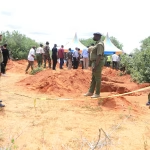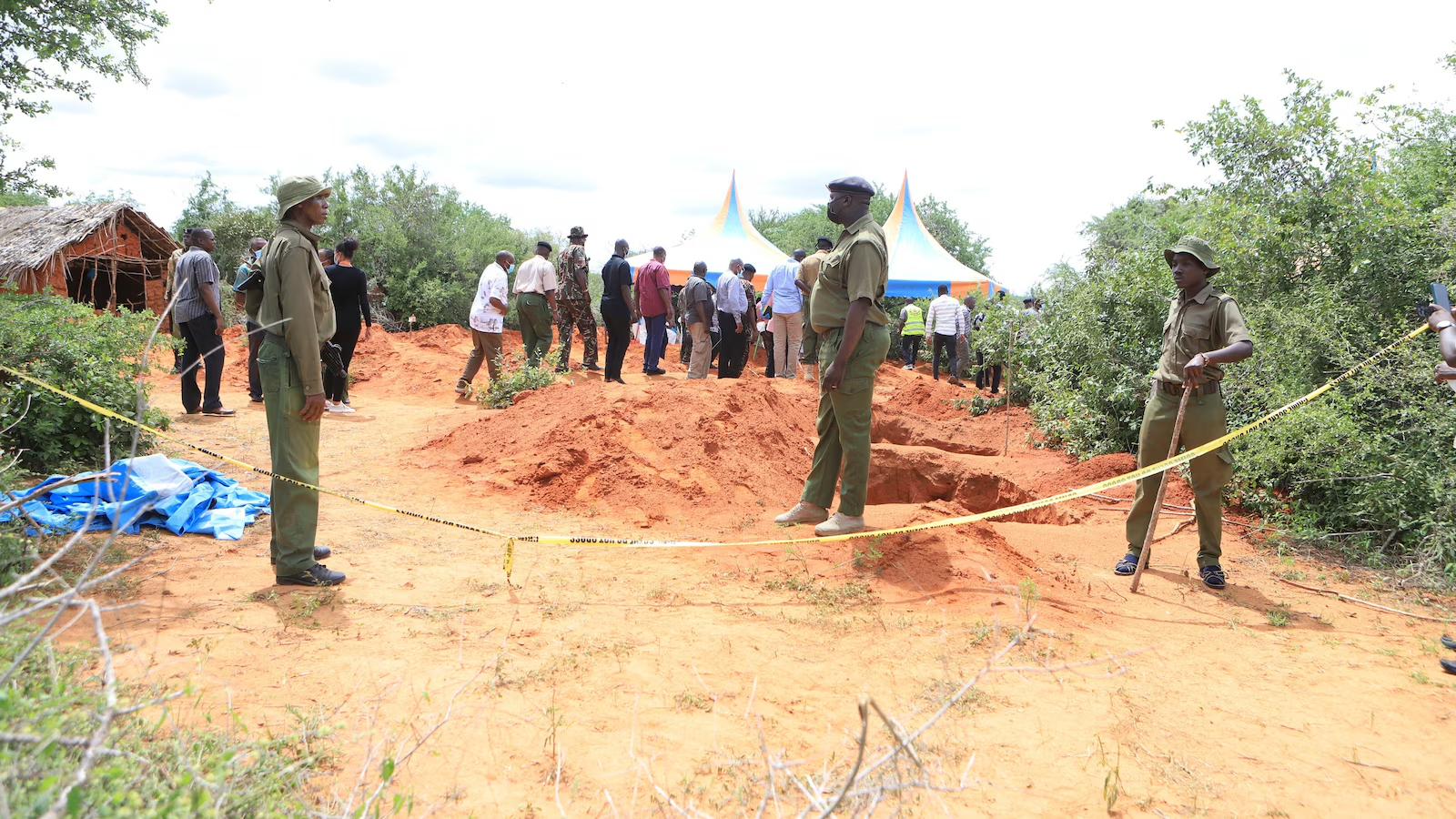The calm coastal atmosphere of Kilifi County, Kenya, has been shattered once again. In August 2025, authorities made a chilling discovery near the town of Malindi—dozens of bodies buried in shallow graves. The site lies just a few kilometers from the infamous Shakahola Forest, where hundreds of followers of a starvation cult lost their lives in 2023.
These new findings have reignited painful memories of a tragedy that stunned the world and exposed deep cracks in Kenya’s systems of religious oversight, law enforcement, and community protection. Behind every grave is a story of manipulation, misplaced faith, and failed safeguards.
This article takes a comprehensive look at the events surrounding this shocking discovery: the background of the Shakahola cult, what investigators have uncovered so far, the survivors’ stories, and the broader social and legal implications.
A Grim Discovery: What We Know So Far
The Scene of the Discovery
In August 2025, Kenyan authorities discovered shallow graves near Kwa Binzaro in Kilifi County, roughly two kilometers from the original Shakahola site. The bodies were found after weeks of intelligence gathering, following reports from locals who noticed unusual activities in the area.
The Numbers So Far
Initial reports confirm that five bodies were exhumed, but forensic teams suggest there may be at least nine victims, including two children. Investigators believe the graves could be connected to cult members who were either trying to escape detection or continuing secret rituals long after the original cult dismantlement.
The Investigations Begin
Kenya’s homicide detectives, forensic experts, and pathologists are now working together to determine the causes of death. Preliminary autopsy reports indicate a mix of starvation and possible suffocation. Authorities have launched a manhunt for individuals suspected of orchestrating these new burials, while eleven suspects remain under active investigation.
The Shakahola Cult Tragedy: A Dark Chapter Revisited
The 2023 Starvation Massacre
To understand the current events, we must revisit April 2023, when authorities uncovered a horrifying scene in the Shakahola Forest. Hundreds of shallow graves contained the bodies of followers of Pastor Paul Nthenge Mackenzie, the leader of the Good News International Ministries.
Mackenzie had convinced his followers that the world was ending and that starving themselves to death would allow them to “meet Jesus” sooner. Many of the dead were children, forced into fasting by their parents under Mackenzie’s instructions.
The Scale of the Atrocity
The 2023 incident is one of Kenya’s worst humanitarian disasters in recent memory. Official figures show:
457 confirmed deaths
604 people still missing
Dozens of mass graves discovered
Survivors severely malnourished and traumatized
Mackenzie’s Arrest and Trial
Following global outrage, authorities arrested Paul Mackenzie and charged him with murder, terrorism, manslaughter, and child abuse. He is currently on trial, but despite his detention, these new burials suggest that remnants of his ideology persist, possibly fueled by followers still committed to his apocalyptic teachings.
How Did It Happen? The Anatomy of a Cult
Exploiting Faith and Fear
Mackenzie’s sermons blended biblical prophecy, fear-mongering, and conspiracy theories, convincing people that society was “corrupted by evil” and salvation lay only in abandoning modern life. He urged followers to reject medicine, education, and technology, isolating them from outside influence.
Vulnerability and Manipulation
Most victims came from financially struggling families, seeking hope and healing. Many were persuaded to give up their livelihoods, sell property, and retreat into the forest, where they surrendered full control of their lives to Mackenzie.
Systemic Oversight Failures
Despite multiple complaints from locals and early warnings from human rights groups, authorities failed to act swiftly. Weak religious oversight, limited law enforcement resources, and political hesitation allowed Mackenzie’s cult to grow unchecked.
Survivors’ Voices: Stories from the Ground
Several survivors of the original Shakahola tragedy describe years of psychological control and isolation. One woman, rescued in 2023, recalls being told that eating food was a sin and refusing meant earning “eternal life.”
Another survivor spoke of children being forced to fast under the watchful eyes of senior cult members. Many survivors still suffer severe trauma, malnutrition, and depression—with little access to mental health resources.
These stories underline the urgency of stronger protections and community awareness.
The Government’s Response
Following both the 2023 tragedy and the new 2025 discoveries, the Kenyan government has:
- Launched an in-depth investigation into the cult’s operations.
- Strengthened laws regulating religious organizations to prevent abuse of faith.
- Deployed forensic teams to locate and identify missing persons.
- Provided emergency shelters for rescued survivors and their families.
- However, critics argue that these measures are too little, too late, especially as evidence suggests cult remnants remain active.
The Psychological Toll on Communities
The Shakahola tragedy and the new graves have left a lasting mark on the Kilifi County community:
Families are traumatized by the loss of loved ones and uncertainty about missing relatives.
Survivors face stigma, often shunned by neighbors who view them as willing participants.
Children who escaped suffer from post-traumatic stress disorder (PTSD) and struggle to reintegrate into schools.
Experts stress the urgent need for trauma counseling, community healing programs, and public education campaigns to combat extremist religious ideologies.
Broader Implications: Faith, Freedom, and Regulation
The tragedy raises critical questions:
How do governments protect citizens from exploitative religious leaders without violating freedom of worship?
What role should local communities play in detecting early warning signs?
How can mental health services help prevent manipulation and radicalization?
Kenya now faces the challenge of balancing religious freedom with public safety—a debate that extends far beyond its borders.
FAQs
Where were the bodies discovered?
Near Kwa Binzaro in Kilifi County, roughly two kilometers from the Shakahola Forest.
How many bodies were found?
At least five bodies so far, but forensic experts believe the number could rise to nine or more.
Are these deaths linked to the Shakahola starvation cult?
Yes. Investigators believe these graves are directly connected to Mackenzie’s followers.
Who is leading the investigation?
Kenya’s homicide detectives, forensic experts, and pathologists are collaborating on the case.
Are there any suspects?
Eleven individuals are under investigation, believed to be connected to cult remnants.
What happens next?
Authorities plan to continue excavations, perform autopsies, and pursue legal action against those responsible.
Conclusion:
The discovery of new graves near the Shakahola site is not just an isolated incident—it’s a painful reminder of how unchecked extremism can devastate communities. Behind every body recovered lies a story of lost dreams, broken families, and manipulated faith.
Kenya now faces a dual challenge: seeking justice for the victims while preventing future tragedies. This means enforcing stronger regulations, investing in mental health support, and promoting community awareness about the dangers of cult manipulation.
For the families still searching for answers, the hope is that this investigation will bring closure and spark lasting reforms—so no other community ever has to endure such horror again.














